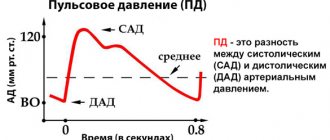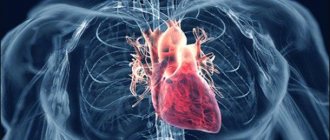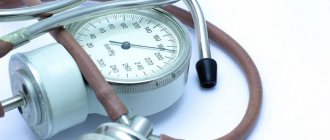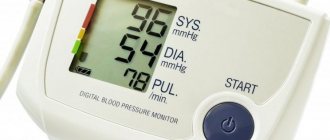Increased systolic pressure with normal diastolic pressure is a sign of a disease such as isolated hypertension. What causes the increase in blood pressure, how dangerous is this pathology and what measures need to be taken to avoid complications?
What does increased blood pressure mean?
As you know, doctors distinguish two types of pressure in humans - lower and upper. A lower rate is observed during diastole, that is, at the moment of relaxation of the heart muscle. Diastolic pressure measures how much resistance the peripheral blood vessels have.
What does increased systolic blood pressure mean? This indicator reflects the force of the heart muscle contracting and pushing out blood. The level of systolic pressure largely depends on the intensity of myocardial contraction, the resistance force of the vascular walls and the frequency of contractions per minute.
In a healthy adult, the upper reading usually does not exceed 110-120 mm Hg. Art., and the lower one – 70-80 mm Hg. Art. The pulse difference between diastolic and systolic pressure is approximately 35-40 mmHg. Art. – this is the name of the gap between these indicators. If blood pressure increases or decreases unevenly, the patient should consult a doctor.
Who's at risk
If systolic pressure is elevated and diastolic pressure is normal, you should consult a doctor and undergo an examination. Most often, isolated hypertension is accompanied by increased heart rate and increased pulse rate. This problem is usually observed in older people. In young patients, this cardiovascular disease is diagnosed extremely rarely, and, according to statistics, men suffer from this pathology much less often than women.
We can talk about the causes of increased systolic pressure with normal diastolic pressure for quite a long time, and all because at the moment doctors cannot say exactly what factors provoke the disorder. According to one version, blood pressure indicators are influenced by a person’s level of stress resistance, emotional shocks he has experienced, etc., but most experts still argue that isolated hypertension can be considered a sign of aging of the body.
Regardless of the cause of increased systolic pressure, treatment of the disease must be carried out. This will avoid a number of complications and stop the process of wear and tear of the cardiovascular system. Hypertension can cause myocardial infarction, heart failure, or stroke.
Video on the topic
About the reasons for the increase and methods of treating high lower blood pressure:
If, when measuring the patient’s blood pressure, the lower pressure readings are repeatedly elevated, while the upper pressure remains normal, the doctor, after a comprehensive examination, makes a diagnosis of isolated diastolic hypertension. The main causes of this condition are endocrine system disorders, adrenal gland pathologies, kidney diseases, and cardiovascular diseases.
If symptoms are detected, therapy should be aimed at removing excess water from the body. Drugs for treatment have a diuretic effect: Veroshpiron, Indap, Hypothiazide, Triampur. If necessary, the doctor prescribes calcium and beta blockers: Atenolol, Metoprol, Verapril. Folk remedies are included in therapy: teas and herbal infusions. To prevent diastolic hypertension, it is necessary to limit the daily intake of salt and canned foods.
The information on the MyMedNews.ru website is for reference and general information, collected from publicly available sources and cannot serve as a basis for making a decision on the use of medications in the course of treatment.
MyMedNews.ru
And we also have
Dietary supplement for blood pressure Normallife: composition, recommendations for use and controversy about effectiveness
During pregnancy
If isolated hypertension is diagnosed in a woman during pregnancy, it is not advisable to delay a visit to a cardiologist. The thing is that for pregnant women, mild hypertension is considered normal. There is no concern about a slight increase in both indicators, that is, diastolic and systolic blood pressure. An elevated upper level may indicate serious malfunctions of the heart or blood vessels. If systolic pressure exceeds the norm, the expectant mother must undergo an ECG, ultrasound, and vascular angiography.
Why is the top rate rising?
If systolic pressure is increased, the reasons should be sought in the individual characteristics of the cardiovascular system. Isolated hypertension is of two types - primary and secondary. The primary form occurs independently against the background of age-related disruptions in the functioning of the body, and the secondary form is a consequence of the progression of other pathologies.
The older a person is, the worse his heart functions. Blood vessels also lose their elasticity with age. They become brittle due to decreased collagen production in the body. As a result, the pressure increases, the upper indicator increases especially noticeably. Heart valve insufficiency can also cause secondary isolated hypertension. Such pathologies occur in people of any age, even children.
A change in diastole, in contrast to high systolic pressure, which directly indicates poor heart function or unsatisfactory vascular condition, indicates impaired renal function.
Symptoms and signs
An increase in systolic pressure with normal diastolic pressure occurs in overweight patients with a hereditary predisposition to diseases of the cardiovascular system. Some medications can cause an increase in the upper level. In this case, the patient will experience the following symptoms of isolated hypertension:
- sleep disorders;
- swelling of the face, lower extremities;
- numbness and tingling in the fingers;
- headache, dizziness;
- nervousness, lethargy;
- anxiety;
- rapid pulse;
- chills;
- failures in coordination of movements.
- stroke;
- anemia;
- acute heart attack;
- heart failure;
- renal pathologies;
- malignant hypertension and death.
The risk posed by a one-time increased systolic pressure with normal diastolic pressure is minimal. If the problem occurs for the first time, it can be cured forever. But when hypertension becomes a chronic condition, the patient's risk of developing:
Folk remedies for high blood pressure
In addition to medications at home, folk remedies for high blood pressure are popular:
- foot baths with temperature changes - pour hot water into one basin, cold water into another, alternately soak your feet for two minutes in the heat and half a minute in the cold;
- vinegar compress – stand on a towel soaked in apple cider vinegar and water in a 1:1 ratio;
- acupressure – massage the forehead, crown, temples;
- alcohol tincture of calendula - take 30 drops three times a day;
- cold compress - apply an ice compress to your neck three times a day, hold until completely melted and lubricate with oil.
Pressure indicators that should alert you
In the initial stages, arterial hypertension does not manifest itself in any way. The first changes are felt by people when the disease reaches the second stage. The optimal systolic blood pressure is 120 mmHg. Art., diastolic – 80 mm Hg. Art. Increasing the upper parameter by nine units, and the lower one by four, is considered the norm.
Pathological changes are usually indicated by borderline hypertension. In this case, the indicators are in the range of 130/85 – 139/89 mmHg. Art. If, during repeated measurements, pressure was recorded above 140/90 mm Hg. Art., the first degree of hypertension is diagnosed, above 160/100 mm Hg. Art. – second degree, more than 180/110 – third.
High diastole readings
There are many reasons for increased diastolic pressure with normal systolic pressure. The lower blood pressure limit may change if:
In addition to these reasons, there are also a number of factors that increase the risk of blood pressure disorders - heredity, age, gender. As the disease progresses, symptoms of high diastolic pressure include nosebleeds, loss of visual acuity, insomnia, lethargy, and feeling tired even after resting. With constant hypertension, the heart muscle quickly wears out, increasing the risk of heart attack and stroke.
Medicines to solve the problem
If the increase in diastolic pressure is repeated repeatedly, then you cannot do without pills. Doctors distinguish 3 main groups of medications:
- ACE inhibitors. Vasodilating drugs block a certain enzyme, due to which the vessels gradually dilate and blood flows through the vessels more easily. Thus, diastolic pressure decreases and does not have a destructive effect on the heart muscle.
- Beta blockers. They counteract adrenaline and prevent it from entering the heart. Thus, the heart muscle is more relaxed, the organ contracts less often and with less force, and the pressure drops.
- Calcium antagonists. They have a relaxing effect on the cells, so the pressure decreases.
The first group of medications includes:
- Benazepril. Its effect appears an hour and a half after administration. The daily dose of the drug is 20 mg per day. You need to start with a lower dose - 10 mg; if there are no pronounced side effects, the dosage is gradually increased. After taking the pill, you should not eat anything for an hour. Doctors advise taking Benazepril twice a day during the period of time when an increase in lower blood pressure most often occurs.
- Lotensin. The drug has proven itself to be effective against high diastolic pressure. Start taking the tablets with minimal doses and, if it does not cause any negative reactions, the dose is gradually increased. Before starting therapy, you need to undergo an examination to determine the cause of the increased readings. The dose prescribed by the doctor is taken twice a day (morning and evening). The duration of treatment with the drug is determined by the doctor.
- Spirapril. This drug is well tolerated by patients and does not require dose reduction even in the presence of kidney disease. Thanks to its prolonged action, it allows you to take 3-6 mg tablets only once a day. Spirapril is taken until the condition improves.
Is it possible to lower the upper pressure yourself?
If systolic pressure has risen sharply, but such episodes have not occurred before, there is no need to panic. First of all, you need to calm down, sit down and take a few deep breaths. It is advisable to postpone tasks that require mental and physical activity until later.
Before looking for potent antihypertensive drugs in the medicine cabinet, you need to take a cool shower and ventilate the room. A few drops of motherwort tincture, valerian, peony and other sedatives will help reduce blood pressure. Among the folk remedies, it is worth noting decoctions of chamomile and rose hips, which are prepared at the rate of one tablespoon of dry raw materials per two glasses of boiling water. You need to infuse the product for 20-30 minutes.
Prevention of a jump in diastolic indicator
Compliance with comprehensive preventive measures helps prevent a re-increase in the lower arterial level:
- Avoid overeating.
- Try to get rid of obesity.
- To refuse from bad habits.
- Stick to the drinking regime.
- Take a contrast shower.
- Go for a therapeutic massage.
- Reduce consumption of sweets and sugar.
- The daily amount of salt consumed is no more than 5 grams (1 tsp), taking into account its presence in ready-made dishes.
- Avoid foods rich in caffeine (chocolate, coffee, etc.).
- Adjust your rest and activity regime so that you have the opportunity to rest during the day and have a good night’s sleep (at least 8 hours). You need to go to bed no later than 10 pm.
- Eliminate fried, salty and fatty foods from your diet.
- Preference should be given to vegetables, fruits, dairy products, fish and other seafood. The best option is a dairy-vegetable diet.
- Lead an active lifestyle, exercise and regularly walk in the fresh air for at least 30 minutes a day.
- Don't forget about routine checkups with your doctor.
Drugs
Whatever the reasons for increased systolic pressure with normal diastolic pressure, this violation cannot be ignored. If the surges become more frequent, you should definitely consult a doctor. The specialist will definitely give a referral for examination, and in order to immediately help the patient, while the test results are being prepared, he will prescribe medications.
Based on the results of the diagnosis, which consists of an electrocardiogram, ultrasound examination of the heart, blood and urine tests, the doctor makes a diagnosis. Confirmed isolated hypertension must be treated in order to first slow down the progression of the disease and neutralize its harmful effects on the patient's body. To alleviate the patient’s condition, medications belonging to the following pharmacological groups will help:
Diuretics and adrenergic blockers are the main medications prescribed to prevent acute cerebrovascular accidents. ACE inhibitors are prescribed to patients with diseases such as diabetes, heart failure, and left ventricular dysfunction. In most cases, it is quite advisable to use several medications at once.
What to do with increased systolic pressure, how to lower the upper level? The most popular “trio” of drugs prescribed by specialists for isolated hypertension includes:
How to increase low diastolic pressure
The principles of treating high systolic pressure are not only to reduce the upper reading, but also to generally stabilize the pressure on the walls of blood vessels. It is necessary to increase diastolic pressure only if the systolic pressure is within the normal range, that is, does not exceed 140 mm Hg. Art.
Methods for raising upper and lower blood pressure are not much different from each other. Everyone knows how to increase systolic pressure (or diastolic) - you need to do what is prohibited for hypertensive patients. The most popular way to raise blood pressure is to drink a cup of black coffee or strong tea. To increase any of the indicators, some users in the reviews recommend using a simple method: eat a small, generously salted piece of bread. The thing is that salt increases the workload on the kidneys, resulting in increased pressure.
If these methods for increasing systolic blood pressure at home do not bring results, you should consult a doctor. It is quite possible that you cannot do without medication here.
Ways to moderately lower lower pressure
They reduce blood pressure at home not only with the help of drugs, but also with other methods. Their essence comes down to the gradual normalization of the work of the heart muscle, since an excessive desire to dilate blood vessels often leads to damage to their walls. The following tips will help you understand how to reduce lower blood pressure without harming the body:
- Change your diet. Vegetables, fruits and fermented milk products should be added to the daily menu to replace junk food. It is advisable to cook by steaming, avoiding fried and smoked foods and canned food.
- The amount of sugar and sugar-containing foods consumed should be reduced. It is recommended to use honey.
- Use table salt to a minimum. No more than 5 g is allowed daily.
- Do not abuse bad habits. Alcoholic drinks and cigarettes disrupt the functioning of internal organs and stimulate the production of adrenaline, which causes blood vessels to constrict.
- Make a work and rest schedule. You need to get at least 6-8 hours of sleep. During work, be sure to take breaks to warm up.
- Do physical therapy. If you have hypertension, you should not overexert yourself, but light physical activity has a beneficial effect on the functioning of the heart muscle. Initially, walking in the fresh air and exercise will suffice. Cardio exercises, running, swimming, cycling and exercise equipment are gradually added.
- Stress stimulates the production of adrenaline. High blood pressure is often the result of nervousness. The patient needs to avoid conflicts, and resolve serious issues after the condition improves.
You can combine advice with folk recipes. A herbalist will help you figure out how to lower your lower blood pressure with their help. He will assess the patient's condition and tell him what to do to stabilize him. The most popular recipes for lowering diastolic pressure are:
- To relieve spasms from blood vessels and strengthen their walls, drink beet juice. It is recommended not only to reduce upper pressure, but also lower pressure. Drink juice 30 ml. before meals for a month.
- Tea made from valerian, hawthorn and motherwort allows the heart to relax and reduces nervous excitability. It is enough to drink 1 cup daily, and your blood pressure will not increase as much as before taking the medicine.
- A mixture of raisins, honey, walnut kernels and dried apricots, poured with lemon juice on top, allows you to reduce high lower pressure. All components are taken in equal shares. Drink 1 tbsp of medicine in the morning on an empty stomach. l.
- Motherwort is used as a means of strengthening the myocardium. For cooking, take 2 tbsp. l. main ingredient and pour 500 ml of boiling water over them. After cooling, drink 50 ml of motherwort infusion at night.
- High lower blood pressure associated with impaired kidney function can be reduced with diuretic herbs. St. John's wort, sage and oregano are used. They need to be taken in equal parts (1 tbsp each) and add 3 tbsp on top. l. motherwort. All components are mixed in one container and 500 ml of boiling water is poured. After cooling, drink 100 ml in the morning for 30 days.
If diastolic pressure has increased sharply, then you can use the following algorithm of actions to gradually reduce it:
- If possible, lie on your stomach. The head should be facing the pillow.
- Place cold objects on the sides of the cervical spine and remove them after half an hour.
- Take any cream or oil and massage the cooled area of your neck. Movements should be light.
- All actions will take no more than 40 minutes. If diastolic pressure continues to rise, call an ambulance.
Taper techniques are effective in treating mild cases of hypertension. In advanced stages, a combination of folk recipes and lifestyle correction with drug therapy is required. Drugs are prescribed by a doctor depending on the patient’s condition and the presence of other pathological processes.
Taking a course of traditional medicine must be agreed upon with a specialist. Many components used in recipes are contained in various preparations. Their combination can cause an overdose and an attack of arterial hypertension. The doctor will have to take this nuance into account and change the dosage.
Prevention of hypotension
To keep your diastolic or systolic blood pressure under control in the future, you need to carefully monitor your health and lifestyle. The first thing hypotensive people need is to adjust their diet, get proper rest and moderate physical activity.
Do not underestimate the importance of diet for blood pressure disorders. If it is advisable for hypertensive patients to give up sweets, salty, fatty and spicy foods, then for hypotensive patients these same foods will bring more benefit than harm. The patient's daily menu should include vegetables, fruits, meat, fish, and dairy products. In addition, people with low blood pressure:
Dietary changes
Below are some dietary changes that may help you control your blood pressure.
Limit your alcohol intake
Drinking too much alcohol can raise your blood pressure to unhealthy levels.
The AHA recommends that women drink no more than one drink per day, and men drink no more than two drinks per day ().
1 “drink” = 1 glass of 40% vodka or cognac (40 ml), 1 glass of 12% wine (150 ml), 1 glass of 7% malt liquor (230 ml) or 1 small glass of 5% beer (350 ml).
Limit your caffeine intake
Caffeine may increase blood pressure in some people. Johns Hopkins Medicine states that if a person's blood pressure rises 5 to 10 points within 30 minutes of consuming caffeine, they should consider limiting their caffeine intake ().
Reduce your sodium intake
Salt intake reduces the kidneys' ability to remove water from the blood. Excess fluid inside the body increases a person's blood pressure.
According to a 2020 review, researchers recommend that people reduce their total sodium intake to 2 grams or less each day. This should help lower blood pressure and improve the function of veins and arteries ().
You need to avoid adding excess salt to your food and avoid foods that contain added sodium.
Increase your potassium intake
Potassium helps lower blood pressure in two ways: by helping the body release sodium from urine and by easing tension in the walls of blood vessels.
Potassium-rich foods include:
- bananas
- potato
- spinach
- avocado
Before considering adding extra potassium to your diet, you should talk to your doctor. According to the AHA, potassium may harm people who have certain medical conditions, such as kidney disease, or who take certain medications ().
Limit your intake of saturated and trans fats
The AHA recommends that people limit their daily intake of saturated fat. According to the AHA, saturated fat should account for no more than 120 calories in a 2,000-calorie per day diet ().
The AHA also recommends avoiding trans fats, which can increase levels of "bad" LDL cholesterol while lowering levels of "good" HDL cholesterol. Like high blood pressure, trans fats increase your chance of developing heart disease and stroke ().
Avoid Sugar
According to a 2014 review, reducing your intake of fructose and other sugars may help lower your blood pressure ().
To reduce your risk of high blood pressure and heart disease, the authors recommend avoiding added sugar in processed foods.
Eat Heart-Healthy Foods
A person with high blood pressure should focus on eating foods that are low in saturated fat, trans fat, sugar and salt.
To improve cardiovascular health, the Office of Disease Prevention and Health Promotion recommends that people consume more of the following foods ():
- fiber-rich foods such as fruits and vegetables
- low-fat or skim dairy products
- whole grain bread, cereals and pasta
- Protein-rich foods such as nuts, tofu and eggs
- vegetable oils such as olive oil and sunflower oil
For people with high blood pressure, the NHLBI recommends the DASH diet. This meal plan helps maintain heart health by lowering blood pressure and cholesterol levels ().
Include probiotics in your diet
According to a 2020 study, probiotic strains of lactobacilli and bifidobacteria produce chemicals that can lower blood pressure ().
The study authors concluded that probiotics may help people with conditions that can cause high blood pressure. However, scientists must conduct further research to support these claims. It is also unclear whether taking probiotics reduces blood pressure in people who do not have an underlying medical condition.
Foods high in probiotics include:
- natural yogurt
- kefir
- sauerkraut
- kimchi
- miso
- kombucha
- other fermented vegetables
First aid for blood pressure disorders
A person who suddenly feels unwell must have their blood pressure measured. If it turns out to be lower or higher than normal, you need to act according to the following algorithm:











